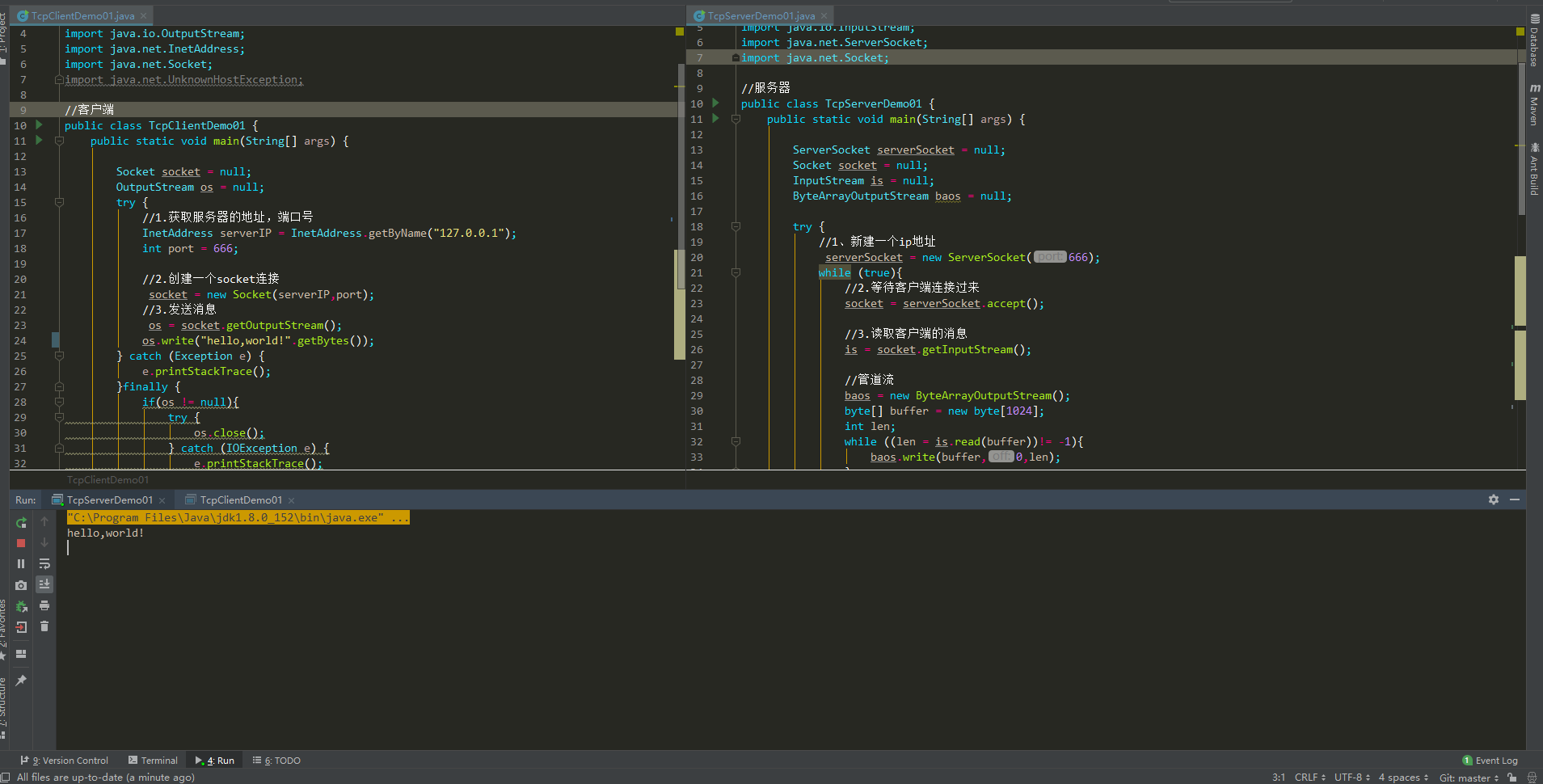标签:管道流 load mamicode ddr aos NPU pac 客户 客户端
1.获取服务器的地址,端口号
//1.获取服务器的地址,端口号
InetAddress serverIP = InetAddress.getByName("127.0.0.1");
int port = 666;
2.创建一个Socket连接,参数为:地址和端口号
//2.创建一个Socket连接
Socket socket= new Socket(serverIP,port);
3.往服务器发送内容
//3.发送消息
OutputStream os = socket.getOutputStream();
os.write("hello,world!".getBytes());
4.关闭流(先开后关)
//4.关闭流
if(os != null){
try {
os.close();
} catch (IOException e) {
e.printStackTrace();
}
}
if(socket != null){
try {
socket.close();
} catch (IOException e) {
e.printStackTrace();
}
1.创建一个IP地址
//1、新建一个ip地址
ServerSocket serverSocket = new ServerSocket(666);
2. 等待客户端连接过来
//2.等待客户端连接过来
Socket socket = serverSocket.accept();
3.读取客户端的信息
//3.读取客户端的消息
is = socket.getInputStream();
//管道流
baos = new ByteArrayOutputStream();
byte[] buffer = new byte[1024];
int len;
while ((len = is.read(buffer))!= -1){
baos.write(buffer,0,len);
}
System.out.println(baos.toString());
4.关闭流
//4.关闭流
if(baos != null){
try {
baos.close();
} catch (IOException e) {
e.printStackTrace();
}
}
if(is != null){
try {
is.close();
} catch (IOException e) {
e.printStackTrace();
}
if(socket != null){
try {
socket.close();
} catch (IOException e) {
e.printStackTrace();
}
if(serverSocket != null){
try {
serverSocket.close();
} catch (IOException e) {
e.printStackTrace();
}
}
package com.gitee.luee.network;
import java.io.IOException;
import java.io.OutputStream;
import java.net.InetAddress;
import java.net.Socket;
import java.net.UnknownHostException;
//客户端
public class TcpClientDemo01 {
public static void main(String[] args) {
Socket socket = null;
OutputStream os = null;
try {
//1.获取服务器的地址,端口号
InetAddress serverIP = InetAddress.getByName("127.0.0.1");
int port = 666;
//2.创建一个socket连接
socket = new Socket(serverIP,port);
//3.发送消息
os = socket.getOutputStream();
os.write("hello,world!".getBytes());
} catch (Exception e) {
e.printStackTrace();
}finally {
if(os != null){
try {
os.close();
} catch (IOException e) {
e.printStackTrace();
}
}
if(socket != null){
try {
socket.close();
} catch (IOException e) {
e.printStackTrace();
}
}
}
}
}
package com.gitee.luee.network;
import java.io.ByteArrayOutputStream;
import java.io.IOException;
import java.io.InputStream;
import java.net.ServerSocket;
import java.net.Socket;
//服务器
public class TcpServerDemo01 {
public static void main(String[] args) {
ServerSocket serverSocket = null;
Socket socket = null;
InputStream is = null;
ByteArrayOutputStream baos = null;
try {
//1、新建一个ip地址
serverSocket = new ServerSocket(666);
while (true){
//2.等待客户端连接过来
socket = serverSocket.accept();
//3.读取客户端的消息
is = socket.getInputStream();
//管道流
baos = new ByteArrayOutputStream();
byte[] buffer = new byte[1024];
int len;
while ((len = is.read(buffer))!= -1){
baos.write(buffer,0,len);
}
System.out.println(baos.toString());
}
} catch (IOException e) {
e.printStackTrace();
}finally {
if(baos != null){
try {
baos.close();
} catch (IOException e) {
e.printStackTrace();
}
}
if(is != null){
try {
is.close();
} catch (IOException e) {
e.printStackTrace();
}
}
if(socket != null){
try {
socket.close();
} catch (IOException e) {
e.printStackTrace();
}
}
if(serverSocket != null){
try {
serverSocket.close();
} catch (IOException e) {
e.printStackTrace();
}
}
}
}
}

至此,实现一个简单的tcp传递信息的例子就完成了。
标签:管道流 load mamicode ddr aos NPU pac 客户 客户端
原文地址:https://www.cnblogs.com/lyj-tec-blog/p/14265080.html